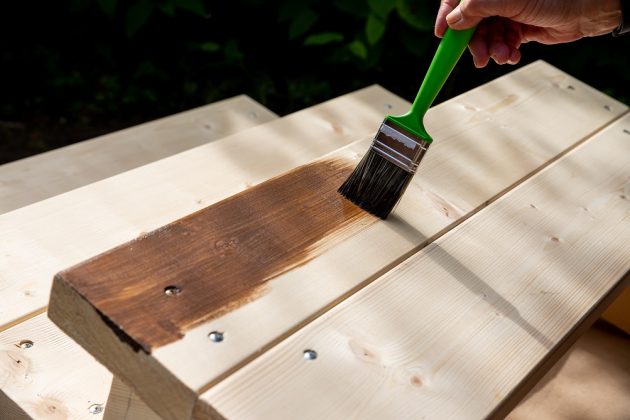Art allows us to rediscover ourselves as well as being an excellent method to enjoy the leisure, whether alone or even with the kids. It provides us a feeling of accomplishment and acts as a fantastic stress killer. At woodhappen.com we understand the enthusiasm that wood craftsmen have, therefore we produced this information to answer issues and assist you in selecting the right paint for particular wood projects.
While many individuals think of acrylic paints, they may conjure up images of canvas painting. Will acrylic color, on the other hand, be used on timber? Definitely! Acrylic paints may be utilised on a variety of materials, including metal, textiles, leather, paper, and any other substance which does not possess a glossy or greasy finish. Acrylic colour on wood is among the greatest methods for working on timber.

Is Acrylic Paint Safe to Use on Wood?
Water-based acrylics paint is composed by pigments dispersed within basic acrylic polymer solution. As a result, acrylic colour has been non-toxic, dries rapidly, and thus can be readily wiped off with water plus soap. This style of paint is suitable for a wide range of woods.
Acrylic paint seems to be a great alternative for several acrylic painting on wooden projects for all of above factors. Not just it is simple to apply, but the colors can be found practically anyplace. Because it has been toxic free, it is an excellent choice for indoor task. It is advised that you prepare your surface layer before applying acrylic colors for the better effect.
Wood is much more cheaper than canvas as well as has a harder surface, which should assist to minimise cracking when drying. Properly prepping the wood board will result in a flawlessly flat surface for applying the acrylic colours.
Yet, wood is much heavier than canvas and, though not properly polished or kept unprimed or untreated, can cause discolouration and reduce the longevity of the timber piece. Framing wooden items may also be challenging, and when done poorly, can result in difficulties such as cracking. Hanging the timber may be a little more challenging than putting a canvas artwork.
However, you must not let this deter you from producing your acrylic colour on timber project because there are too many options available!
Varieties of Timber Paint
You may believe that all color is the same; however there are various unique kinds of colour which you may utilize on your timber project. Learning further about each kind can assist you in selecting the appropriate color suit your requirements.
Paint using an oil base:
Many individuals prefer oil-based colour since it lasts long after you complete your job. Whenever the color has set, oils produce a silky texture, providing you a good matte or shiny appearance, based on the kind of paint you choose. Even better, many oil-based colour applications don’t need an upper coat to achieve this gloss.
To get that flawless finish, though, you must use some high-quality brushes instead of a roller. To achieve the greatest outcomes with this sometimes temperamental paint solution, select one that particularly promises to perform effectively with oils. With this kind, make sure you’re painting straight on the raw timber or primer, as oils don’t blend properly with any latex underlying layer.
Latex Paint:
Working with latex colour is significantly easier than working using oil-based coat. Of course, simplicity of usage correlates to lower durability and more obvious brush sweeps in the completed item. To lessen the quantity of apparent brush sweeps, try putting a bit Floetrol within your paint supply.
Consider the sort of texture you want for your latex coating based on your job. In general, any gloss as well as semi-gloss texture will not require a base coat; however a silky or matte texture will require one for the optimum effects. Latex paints are easily washed with soap as well as water, allowing task completion a snap.
Paint that is water-based:
Water-based colors are commonly found at industrial as well as big-box shops since they seem to be the simplest to apply among other project colors. There is zero requirement for pre-treat any timber unless it has already been coated using oil-based colours, and there has been no requirement to be concerned about mildew development or increased concentrations of odour. Water-based coatings dry rapidly and often resist discoloration and splitting. Water-based colors that are often used contain chalk paint as well as milk paint.
Acrylic Paint for Crafts:
You could be capable to put acrylic craft color on any wooden creation, depending on its size. This is ideally suited for little works or those with a really artistic appeal. Acrylics dry rapidly and have little to no odour. They come in a variety of colours, finishes, and ornamental possibilities. Acrylic portrays, for instance, may be simply mixed to produce your own colours, and these are quite easy to utilize to create distinctive colour effects such as ombre.
Acrylic art paints are affordable and come in a range of thicknesses to accommodate the scale and breadth of your creations. You may reuse your paintbrush with this sort of color over and over if you clean them immediately after use.
Conclusion:
There are many different kinds of colours, and deciding which one to apply on timber can be difficult at first. Evaluate your wood work to guide your decision, and you’ll select a color that will sustain everyday usage and cleaning. Without a doubt, the greatest paint will produce the best effects. You’ll finish up having a wooden product that is just what you hoped for if you follow these guidelines.














